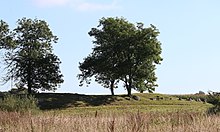Västra Hoby dolmen
The Västra Hoby dolmen ( RAÄ -Nr. Västra Hoby 4: 1) is a Långdös east of Kävlinge in Skåne in Sweden . It dates from the Neolithic Age around 3500 to 2800 BC. And is a megalithic system of the funnel beaker culture (TBK).
The south-east-north-west oriented, somewhat wooded hill of the barren bed measures about 53.0 × 13.0 m and is about 2.4 m high. It is surrounded by 37 curbs of various widths (0.5–1.7 m) and heights (0.3–1.1 m). Magnus Bruzelius (1786–1855) mentions 44 stones around the mound. A burial chamber is not visible, but in the middle there is a pit about 5.0 m in diameter and 0.5 m deep.
There are several hills nearby. The name Ringhügel for the long dolmen of Västra Hoby (analogous to Kung Rings Grav in Denmark - for the Swedish King Sigurd Ring ) is only mentioned by M. Bruzelius. In 1692, hills 3 and 4 are called ( Danish Dansehøje - dt. Dance hill). In 1785 and 1818 hill no. 3 was named Rävkullarna ( German " fox hill " ) and hill no. 4 referred to as Danshög.
See also
Individual evidence
- ↑ Långdös is the name commonly used in Sweden for a long bed, in contrast to this, Runddöser are those systems that are located in a round hill.
Web links
- Dolmen of Västra Hoby - entry in the database "Fornsök" des Riksantikvarieämbetet (Swedish)
Coordinates: 55 ° 47 ′ 23.3 " N , 13 ° 8 ′ 26.8" E

